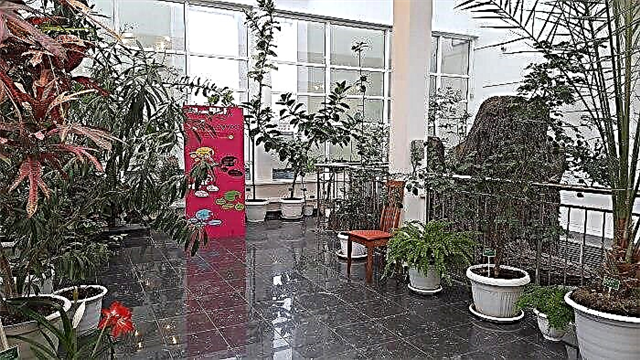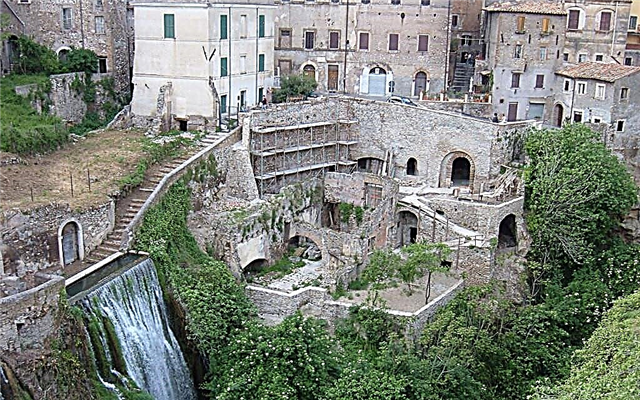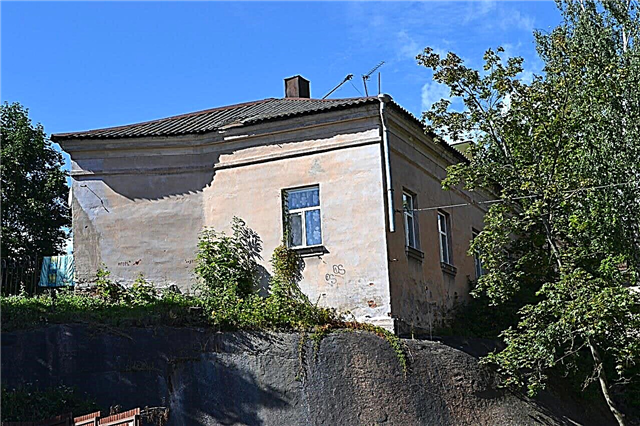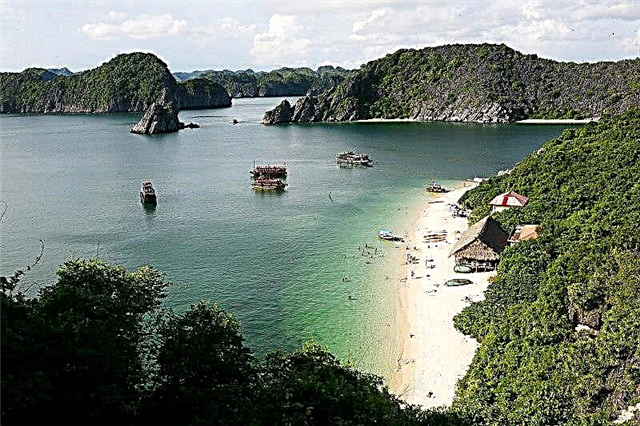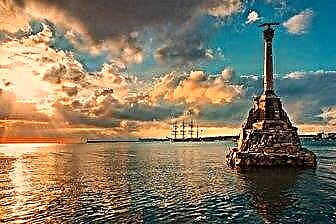Sevastopol is called "the city of glory of the Russian fleet", since many important historical events are associated with the brilliant victories of Russian admirals and sailors in the Crimea. The imperial architecture of Sevastopol's city embankments and promenade boulevards will return tourists to the elegant 19th century, and the relaxed atmosphere of summer evenings will take away all thoughts of worries and problems.
In Sevastopol, a tourist will get acquainted with the priceless cultural treasures of the ancient Chersonesos, enjoy the expressive views of the Black Sea coast and bathe in the clear water of the Sevastopol Bay. The resort life is in full swing in the city from June to the end of September. The central event of August is the annual biker festival, which attracts tens of thousands of people.

Apartments and hotels at affordable prices.
from 500 rubles / day
What to see and where to go in Sevastopol?
The most interesting and beautiful places for walking. Photos and a short description.
Count's pier
A pier within the city limits, decorated with classic terraces and rotundas. In 1783, a wooden pier with numerous port buildings was located on this site. In the first half of the 19th century, it was turned into the front facade of a military port, decorated with decorative elements and antique statues. On the Grafskaya pier there are memorial plaques erected in honor of the Russian emperors.

Chersonesus Tauride
The ruins of an ancient ancient colony that once flourished on the shores of the Crimean peninsula. In those distant times, Crimea was called Taurida, and the rich and prosperous Greek polis was the center of civilization and culture. Presumably, Chersonesos was founded in the 5th century BC. and existed until the XIII-XIV centuries, until it was destroyed by the nomads. The first excavations in the city began in the 19th century. In the XX century, on the basis of the finds, the appearance of the ancient Chersonesos was recreated.

Diorama "Storming Sapun Mountain"
One of the largest works of battle painting, located on Sapun Mountain near Sevastopol. The diorama is located in a semicircular building, from the observation deck inside the room, you can see all the details of the composition. The painting depicts the events of May 7, 1944 (the operation to liberate Sevastopol), when detachments of the Primorsky Army stormed the approaches to Sapun Mountain.

Museum panorama "Defense of Sevastopol"
A panoramic painting 14 meters high, located in a circular exhibition hall of the early 20th century. The canvas tells about the events of the Crimean War of 1853-1856. The creator of the masterpiece F.A. Roubaud captured the battle on the Malakhov Kurgan on June 6, 1855. The panorama was painted in Munich. Students of the Bavarian Academy of Arts and several German painters were involved in the work.

Monument to the Scuttled Ships
A monument located on the embankment of Sevastopol. It is considered an important symbol; its image is present on the city's coat of arms. The obelisk was erected in memory of the ships that were deliberately sunk in the Sevastopol Bay in 1854-55. in order to prevent the Anglo-French fleet from approaching the city. These events took place during the First Defense of Sevastopol during the Crimean War.

Malakhov Kurgan
A memorial complex designed to perpetuate in memory the events of the Crimean War and the Great Patriotic War. Twice in history, the troops held the heroic defense of Sevastopol and defended the city from the enemy. Monuments to the commanders and memorial plaques with the names of the heroes of both wars are placed on the Malakhov Kurgan. For the inhabitants of the city, this place is very revered and almost sacred.

Primorsky Boulevard
City promenade, built on the site of the fortifications of the Crimean War period. The boulevard is a popular vacation spot; there are many historical sights telling about the history of Sevastopol. The alley was founded at the end of the 19th century. At the beginning of the 20th century, an orchestra played here in the evenings, the entrance to one of the sides of the boulevard was paid, and the lower ranks had no right to come here.

Ecopark Lukomorye
An entertainment center for families with several interesting museums, attractions, a zoo corner, a cafe and a theater. A special place in the park is occupied by plots and characters from the tales of A.S. Pushkin. Almost every weekend and on holidays, children's parties and fun game shows are organized on the territory. It will be especially interesting for children to visit the southern residence of Santa Claus.

Tower of Winds
An antique style ventilation tower built in the middle of the 19th century for the needs of the Maritime Library. The structure is built in the shape of an octahedron and is decorated with bas-reliefs depicting characters from Greek mythology. Each side of the tower symbolizes the direction of the wind. The Athenian Tower of the Winds built in the 1st century BC was taken as a model. The Maritime Library burned down in a fire in 1955, but the Tower survived and still adorns the city today.

Theater of the Black Sea Fleet
The theater was created in 1932 by order of Marshal Voroshilov, it became one of the first military professional theaters in the Soviet Union. The troupe gave performances not only on stage, but also on ships. On the stage of the theater, mainly works of naval and revolutionary themes were staged. The stage did not stop working during the Great Patriotic War, despite the fact that costumes and scenery were destroyed during the bombing.

Palace of childhood and youth
Once upon a time throughout the USSR, there were Palaces of Children's Creativity, where children could develop their talents, go to circles and sections, engage in scientific research or learn intellectual games. With the collapse of the country, these establishments were gradually closed. In Sevastopol, there is such a unique Palace of Childhood and Youth, where schoolchildren from 5 to 17 years old can spend their free time for free and with interest.

Sevastopol Art Museum
An architectural monument of the late 19th century, located on Nakhimov Avenue. Inside the building there are three exhibition galleries, where collections of paintings, graphics, sculptures by masters of different eras are presented. The museum contains works by Italian Renaissance artists, representatives of the Flemish school of painting, as well as French, Russian and German painters of the 18th-20th centuries.

Military History Museum of the Black Sea Fleet
An extensive collection dedicated to the history of the Russian Black Sea Fleet since the Russo-Turkish War of 1884-85. before the modern period. Part of the museum's exposition is located on the street, which attracts the attention of people passing by. The museum contains the telescope of Admiral Nakhimov and the saber of the Turkish commander Osman Pasha, who was defeated in the Battle of Sinop. The entire collection is housed in a historic building of classical architecture.

Sevastopol Marine Aquarium Museum
The museum was founded at the very end of the 19th century and became the first oceanarium on the territory of the Russian Empire. The building houses five exhibition halls, which contain marine life from different parts of the world. In addition to fish, there are reptiles, invertebrates, stingrays, eels, sharks, moray eels in aquariums. A separate exposition is dedicated to the inhabitants of the Black Sea. From time to time, themed exhibitions are held on the territory of the museum.

Inkerman cave monastery
An ancient monastic monastery in the vicinity of Sevastopol. According to some sources, the monastery was founded in the VIII century, others point to the XIV-XV centuries.After the establishment of the Ottoman Empire protectorate over the Crimean Peninsula, the Inkerman Cave Monastery gradually fell into decay, its revival took place twice - in the middle of the 19th century and at the end of the 20th century after the collapse of the USSR.

Vladimirsky (Admiralty) Cathedral
Sevastopol Cathedral of the XIX century built in the Russian-Byzantine manner. The architecture of the building resembles the temples of Constantinople of the 9th-10th centuries. The interior decoration is atypical for the Orthodox Church, since instead of icons on the walls there are memorial plaques with the names of the heroes of the First Defense of Sevastopol. The cathedral contains the graves of Russian admirals P. Nakhimov, V. Kornilov, V. Istomin.

Vladimir Cathedral in Chersonesos
The temple, built in memory of the baptism of Prince Vladimir. This significant and epoch-making event for all of Russia took place on the territory of Tauric Chersonesos. The first building of the cathedral in the Byzantine style appeared in the second half of the 19th century under Alexander II, but it was almost completely destroyed during the Great Patriotic War. The temple lay in ruins until the early 2000s. Restoration and re-consecration took place in 2004.

St. Nicholas Church
The temple was erected in honor of the soldiers who died in the Crimean War during the first defense of Sevastopol. The building is part of the memorial complex at the Bratsk cemetery. The cathedral was created according to the original architectural project of A. Avdeev. The structure has the shape of a pyramid topped with a massive cross. The internal walls are lined with marble boards, on which the names of the dead officers are carved.

Cathedral of the Intercession
A picturesque Sevastopol temple, an example of one of the directions of church architecture of the late XIX-XX centuries. After the Revolution of 1917, the cathedral was closed by the Bolsheviks, but opened its doors again during the occupation of Crimea during the Second World War. During the war, the building suffered significant damage, but it was reconstructed by 1947. Since the 60s. XX century on the territory of the temple housed a gym. The Intercession Cathedral returned to the bosom of the Church in 1994.

"35th coastal battery"
A complex of defensive structures of the early 20th century at Cape Chersonesos. The battery was built for the defense of Sevastopol from the sea. The guns of this complex could conduct circular continuous shelling at the enemy, the firing range was more than 40 km. The outer protective walls of the battery were up to 4 meters thick. In 2007, a memorial museum complex was organized on the territory.

Mikhailovskaya battery
Historical museum complex on the northern side of the Sevastopol Bay. The defensive structure was built in the 19th century and survived during the First and Second Defense of Sevastopol. Since 2014, the site has hosted the Maritime Museum, which tells about the history of the Black Sea Fleet, the Crimean War, as well as the First and Second World Wars. More than 20 thousand exhibits are located in 30 halls of the fortress.

Konstantinovskaya battery
Fortification of the XIX century, guarding the Sevastopol Bay. It served as a reliable barrier on the way of enemy ships. The battery housed about 100 guns capable of continuous fire for a long time. During the Second Defense of Sevastopol, she helped the defenders of the city to hold their positions. Next to the Konstantinovskaya battery on the edge of the pier is the white tower of the lighthouse.

Balaklava Bay
A narrow, winding bay, artfully nestled among the rocks. The bay is considered one of the most picturesque on the Black Sea, moreover, it is completely invisible from the side of open water. People began to settle on the shores of the gulf 2.5 thousand years ago, wars were constantly fought over the territory, since several peoples at once wanted to have a place with such a favorable location. In Balaklava Bay, it was possible not only to reliably hide from enemies, but also to make successful raids from here.

Object 825GTS
Former USSR secret facility on the territory of Balaklava Bay. During the Cold War, even the residents of Balaklava did not know about its existence. It housed a submarine base that carried nuclear weapons. In the event of a nuclear attack on the USSR, these boats could retaliate. Until 2014, it was assumed that the premises of the facility will house the museum zone "Cold War Dungeons".

Object "Mole"
An underground facility built in the 30s. XX century. It was originally planned that a power plant would be located on the territory, but the war of 1941-45. violated construction plans. With the onset of peacetime, work resumed, but it went so slowly that the USSR collapsed, and the object was never completed. The concrete labyrinth is still in a frozen state, since neither the Ukrainian nor the Russian government came up with an application for it.

Genoese fortress Chembalo
The fortress stands on the hilly shores of the Balaklava Bay. Only the remains of fortified walls, towers and temple ruins have survived to our time. Several centuries ago, there was a lively trading settlement founded by immigrants from the Republic of Genoa. In total, three similar structures were built on the territory of Crimea - in Sudak, Balaklava and Feodosia. All of them fell into decay after the accession of the Ottoman Empire to the Crimea.

Chorgunsky bridge-aqueduct
A bridge built in the middle of the 19th century on the Chernaya River. It was used as part of the water supply system, which stretched to the Sevastopol Admiralty. The aqueduct is 12 meters long; in summer it is almost invisible because of the dense thickets on the banks of the river. After the Crimean War, the water supply ceased to be supplied through the water supply system, most of the structure was destroyed. The Chorgun aqueduct bridge is the only fully preserved section of this aqueduct.

Georgievskaya rock
A rock towering over the sea surface, 1.5 km. from Cape Fiolent. At the top is a cross dedicated to St. George the Victorious. At 140 meters from the cliff there is Jasper Beach, which is considered one of the best in Crimea. It is a picturesque coastal strip covered with small pebbles of different colors. The water here is always clean and clear. A staircase of 800 steps leads to the beach from the Balaklava St. George Monastery.

Cape Aya
One of the most picturesque sections of the Crimean coast in the vicinity of Balaklava. At the beginning of the XX century, the remains of a developed urban settlement of the X-XV centuries were found on the cape. The name "Ayia" comes from the Greek word "ayos", which means "holy". There is an assumption that in ancient times it was a sacred place for immigrants from Hellas. Another interesting theory claims that the cape was a reference point for sailors who first landed on the shores of Taurida.

Cape Fiolent
The coastline, cut by sheer cliffs, offers a breathtaking view of the Black Sea and the distant coastline. Cape Fiolent has very steep slopes, under which there are excellent beaches, on which the sea water takes on a blue and almost "tropical" hue. Convenient tourist routes are laid along the coast.




